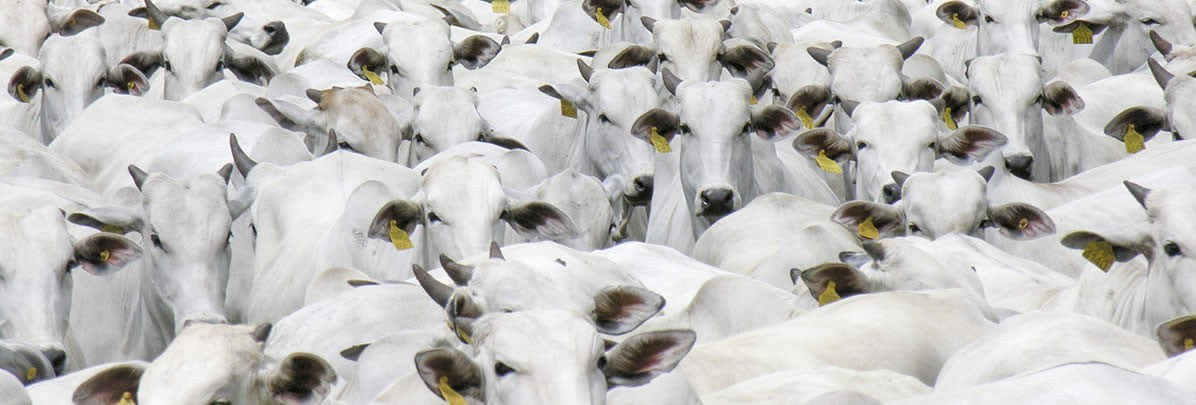Carcass Assessment for Genetic Improvement Programs

The Reviews

Ultrasound Age By Race
|
Raça |
Machos (M)1 |
Fêmeas (F)1 |
Machos (M) confinados |
Fêmeas (F) confinados |
|
Nelore |
490 – 610 |
490 – 610 |
330 – 400 |
330 – 400 |
|
Brahman |
490 – 610 |
490 – 610 |
330 – 400 |
330 – 400 |
|
Guzerá |
490 – 610 |
490 – 610 |
330 – 400 |
330 – 400 |
|
Tabapuã |
490 – 610 |
490 – 610 |
330 – 400 |
330 – 400 |
|
Angus |
- |
- |
320 – 340 |
320 – 360 |
|
Canadian Angus |
- |
- |
320 – 440 |
320 – 460 |
|
Brangus |
- |
- |
310 – 430 |
310 – 430 |
|
Charolais |
- |
- |
320 – 430 |
320 – 430 |
|
Chianina |
- |
- |
320 – 440 |
320 – 460 |
|
Gelbvieh |
- |
- |
320 – 410 |
320 – 410 |
|
Hereford |
- |
- |
330 – 430 |
330 – 430 |
|
Limousin |
- |
- |
300 – 450 |
300 – 450 |
|
Red Angus |
- |
- |
320 – 440 |
320 – 460 |
|
Salers |
- |
- |
330 – 450 |
330 – 450 |
|
Simental |
- |
- |
330 – 440 |
330 – 440 |
|
BIF Guidelines |
- |
- |
320 - 410 |
320 - 410 |
Tips for Creators
|
Responsabilidade do Criador |
Por que é Importante? |
|
Agendamento prévio |
Técnicos de campo usam os seus próprios métodos para agendamento, por isso quanto mais cedo você entrar em contato para agendar as avaliações de ultrassom é mais provável de se conseguir a data desejada para o serviço. Isso também pode lhe dar a oportunidade desta data ser agendada com os outros criadores na mesma região e dividir os custos de viagem. Antes de agendar ter uma idéia do número de cabeças para que o técnico possa estimar o tempo necessário para completar a sessão de escaneamento dos animais. Escolha uma data de avaliação que fique dentro da janela de idade adequada para a raça, para que os dados não sejam perdidos. |
|
Planilhas de campo |
A planilha de campo com informações como RGN, idade, sexo, manejo, lote de manejo, é necessária para verificar se todos os animais que estão na idade adequada foram avaliados e acrescentar informações de animais adicionais o que evitará o atraso no laboratório de interpretação. |
|
Tronco de contenção |
Os animais devem sempre ser contidos em um tronco de contenção adequado para que se possa fazer a avaliação. Isso reduz o movimento e melhora o contato, promovendo imagens com maior qualidade. Ele também acelera as coisas! |
|
Fornecer Eletrecidade Limpa |
A eletricidade é necessária para alimentar o equipamento de ultrassom, computador, tosquiadeira (quando necessário), etc. Um circuito sobrecarregado ou sem aterramento poderá causar interferência e pode comprometer o processamento das imagens de gordura intramuscular. Se estiver usando um uma tosquiadeira pode ser necessário fornecer duas fontes de alimentação. Um gerador pode ser usado se necessário. |
|
Tosquia para ultrassom |
É necessário que os animais que serão avaliados tenham o pêlo com menos de 1,3 cm de comprimento, para uma melhor qualidade da imagem. Animais zebuínos não necessitam deste procedimento. |
|
Manter os animais secos |
Óleo vegetal é o agente de acoplamento usado para permitir que as ondas de ultrassom penetrem a pele e se tenha a formação das imagens. Água e óleo não se misturam. Quando o animal está molhado tem-se uma redução do contato e uma imagem de baixa qualidade. Sob uma cobertura os animais molhados demoram em torno de 40 a 60 minutos para secarem. |
|
Pesar os animais |
Os animais devem ser pesados no dia da avaliação de carcaça, entretanto, podem ser pesados até sete dias antes ou depois da avaliação. Saiba que pesagens após a data da avaliação irá atrasar o envio de imagens para o laboratório. |
|
Manter os animais entrando no tronco |
Basicamente, por favor, não conte com o técnico para “tocar” os animais, a função do técnico é fazer a avaliação de ultrassonografia e as anotações cabíveis, outras funções podem atrapalhar o rendimento do serviço, no entanto, muitos técnicos gostam disso e estão dispostos a ajudar! |

